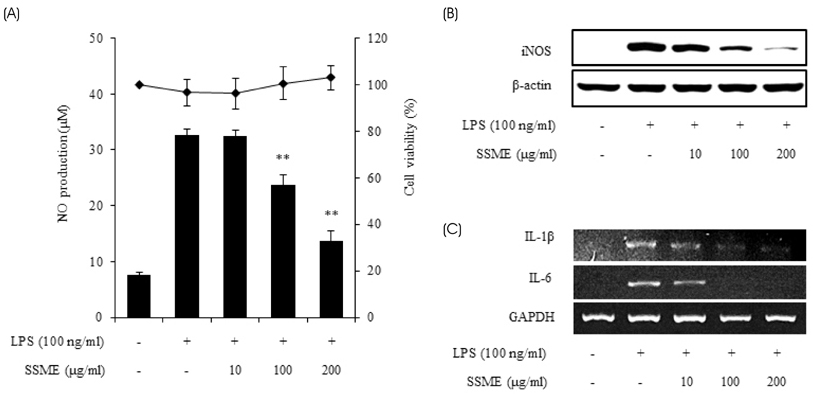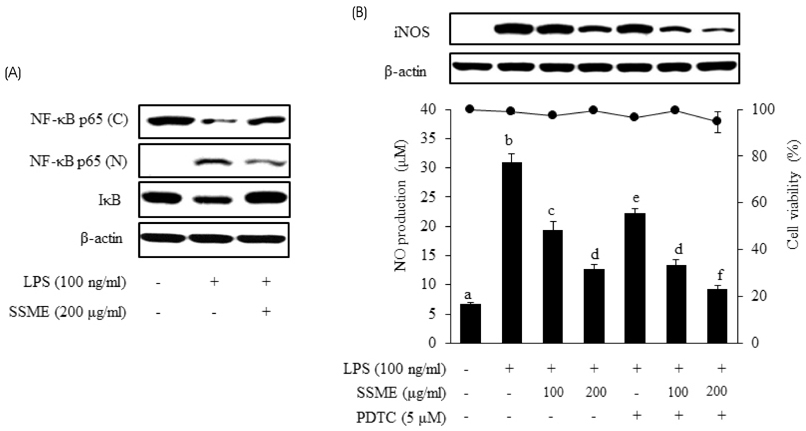J Nutr Health.
2018 Aug;51(4):323-329. 10.4163/jnh.2018.51.4.323.
Anti-inflammatory activities of Scolopendra subspinipes mutilans in RAW 264.7 cells
- Affiliations
-
- 1Department of Biology, Jeju National University, Jeju 63243, Korea. srlee@jejunu.ac.kr
- KMID: 2419503
- DOI: http://doi.org/10.4163/jnh.2018.51.4.323
Abstract
- PURPOSE
The dried body of Scolopendra subspinipes mutilans has long been used as a traditional Korean medicinal food, but little is known about its mechanisms of action. In this study, we investigated the anti-inflammatory activities of Scolopendra subspinipes mutilans and possible mechanisms in lipopolysaccharide (LPS)-stimulated RAW 264.7 cells.
METHODS
Cytotoxicity of Scolopendra subspinipes mutilans extract (SSME) was measured by MTT assay, anti-inflammatory activities were analyzed by nitric oxide (NO) production, the expression of inducible NO synthase (iNOS) and the mRNA level of pro-inflammatory cytokines such as interleukin-1β (IL-1β) and interleukin-6 (IL-6). Nuclear translocation of nuclear factor-kappa B (NF-κB) p65 subunit and degradation of inhibitory kappa B (IκB) were examined by western blot.
RESULTS
SSME inhibited LPS-induced NO production and iNOS expression without cytotoxicity. Up-regulation of LPS-induced pro-inflammatory cytokines, IL-1β and IL-6 was dose dependently attenuated by SSME. Exposure of pyrrolidine dithiocarbamate, an NF-κB specific inhibitor, accelerated the inhibitory effects of SSME on NO production and iNOS expression in LPS-stimulated cells. Moreover, translocation of NF-κB from the cytosol to the nucleus and degradation of IκB were decreased by treatment with SSME in LPS-induced cells.
CONCLUSION
These results suggest that the SSME might have the inhibitory effects on inflammation, partly through inhibition of the NF-κB signaling pathway.
MeSH Terms
Figure
Reference
-
1. Ferrero-Miliani L, Nielsen OH, Andersen PS, Girardin SE. Chronic inflammation: importance of NOD2 and NALP3 in interleukin-1β generation. Clin Exp Immunol. 2007; 147(2):227–235.
Article2. Saha S, Shalova IN, Biswas SK. Metabolic regulation of macrophage phenotype and function. Immunol Rev. 2017; 280(1):102–111.
Article3. Aktan F. iNOS-mediated nitric oxide production and its regulation. Life Sci. 2004; 75(6):639–653.
Article4. Gabay C. Interleukin-6 and chronic inflammation. Arthritis Res Ther. 2006; 8:Suppl 2. S3.5. Meng XM, Tang PM, Li J, Lan HY. Macrophage phenotype in kidney injury and repair. Kidney Dis (Basel). 2015; 1(2):138–146.
Article6. Alexander C, Rietschel ET. Bacterial lipopolysaccharides and innate immunity. J Endotoxin Res. 2001; 7(3):167–202.
Article7. Limtrakul P, Yodkeeree S, Pitchakarn P, Punfa W. Anti-inflammatory effects of proanthocyanidin-rich red rice extract via suppression of MAPK, AP-1 and NF-κB pathways in Raw 264.7 macrophages. Nutr Res Pract. 2016; 10(3):251–258.
Article8. Doyle SL, O'Neill LA. Toll-like receptors: from the discovery of NFκB to new insights into transcriptional regulations in innate immunity. Biochem Pharmacol. 2006; 72(9):1102–1113.
Article9. Pemberton RW. Insects and other arthropods used as drugs in Korean traditional medicine. J Ethnopharmacol. 1999; 65(3):207–216.
Article10. Kim SC, Seo GY, Lee SW, Park SJ, Kim JH, Ahn SH, Hwang SY. Biological activities of Scolopendrid Pharmacopuncture. J Pharmacopuncture. 2010; 13(3):5–13.
Article11. Ding D, Guo YR, Wu RL, Qi WY, Xu HM. Two new isoquinoline alkaloids from Scolopendra subspinipes mutilans induce cell cycle arrest and apoptosis in human glioma cancer U87 cells. Fitoterapia. 2016; 110:103–109.12. Ma W, Liu R, Qi J, Zhang Y. Extracts of centipede Scolopendra subspinipes mutilans induce cell cycle arrest and apoptosis in A375 human melanoma cells. Oncol Lett. 2014; 8(1):414–420.13. Lee W, Hwang JS, Lee DG. A novel antimicrobial peptide, scolopendin, from Scolopendra subspinipes mutilans and its microbicidal mechanism. Biochimie. 2015; 118:176–184.14. Lee JH, Kim IW, Kim MA, Ahn MY, Yun EY, Hwang JS. Antimicrobial activity of the scolopendrasin V peptide identified from the centipede Scolopendra subspinipes mutilans. J Microbiol Biotechnol. 2017; 27(1):43–48.15. Kim IW, Lee JH, Kwon YN, Kim SH, Yun EY, Nam SH, Ahn MY, Hwang JS. Inhibitory effect of melanin synthesis using organic solvent extracts from Scolopendra subspinipes mutilans. J Seric Entomol Sci. 2014; 52(1):1–5.16. Hakim MA, Yang S, Lai R. Centipede venoms and their components: resources for potential therapeutic applications. Toxins (Basel). 2015; 7(11):4832–4851.17. Blum-Degen D, Müller T, Kuhn W, Gerlach M, Przuntek H, Riederer P. Interleukin-1β and interleukin-6 are elevated in the cerebrospinal fluid of Alzheimer's and de novo Parkinson's disease patients. Neurosci Lett. 1995; 202(1-2):17–20.18. Jiang Z, Li C, Arrick DM, Yang S, Baluna AE, Sun H. Role of nitric oxide synthases in early blood-brain barrier disruption following transient focal cerebral ischemia. PLoS One. 2014; 9(3):e93134.
Article19. Sharma JN, Al-Omran A, Parvathy SS. Role of nitric oxide in inflammatory diseases. Inflammopharmacology. 2007; 15(6):252–259.
Article20. Li M, Dai FR, Du XP, Yang QD, Chen Y. Neuroprotection by silencing iNOS expression in a 6-OHDA model of Parkinson's disease. J Mol Neurosci. 2012; 48(1):225–233.
Article21. Yoon YI, Hwang JS, Kim MA, Ahn MY, Lee YB, Han MS, Goo TW, Yun EY. Inhibition of inflammation by Popillia flavosellata ethanol extract in LPS-induced RAW264.7 macrophages. J Life Sci. 2015; 25(9):993–999.22. Kim HJ, Kim DH, Lee JY, Hwang JS, Lee JH, Lee SG, Jeong HG, An BJ. Study of anti-inflammatory effect of CopA3 peptide derived from Copris tripartitus. J Life Sci. 2013; 23(1):38–43.23. Kim DH, Kim HJ, Lee JY, Hwang JS, Kim IW, Lee SG, Jeong HG, An BJ. Anti-inflammatory effect of HaGF peptide of Harmonia axyridis. J Life Sci. 2013; 23(4):495–500.24. Yoon YI, Chung MY, Hwang JS, Goo TW, Ahn MY, Lee YB, Han MS, Yun EY. Anti-inflammatory effect of Oxya chinensis sinuosa ethanol extract in LPS-induced RAW 264.7 cells. J Life Sci. 2014; 24(4):370–376.25. Kim JE, Kim SG, Kang SJ, Kim CS, Choi YS. Effect of antioxidation and antibacterial activity on crude extract and characterization of american cockroaches (Periplaneta americana L.) in Korea. J Seric Entomol Sci. 2015; 53(2):135–142.26. Park YJ, Kim HS, Lee HY, Hwang JS, Bae YS. A novel antimicrobial peptide isolated from centipede Scolopendra subspinipes mutilans stimulates neutrophil activity through formyl peptide receptor 2. Biochem Biophys Res Commun. 2017; 494(1-2):352–357.27. Yoon CH, Kim DC, Ko WM, Kim KS, Lee DS, Kim DS, Cho HK, Seo J, Kim , SY , Oh H, Kim YC. Anti-neuroinflammatory effects of quercetin-3-O-glucuronide isolated from the leaf of Vitis labruscana on LPS-induced neuroinflammation in BV2 cells. Korean J Pharmacogn. 2014; 45(1):17–22.28. Park E, Chun HS. Green tea polyphenol epigallocatechine gallate (EGCG) prevented LPS-induced BV-2 microglial cell activation. J Life Sci. 2016; 26(6):640–645.29. Beinke S, Ley SC. Functions of NF-κB1 and NF-κB2 in immune cell biology. Biochem J. 2004; 382(Pt 2):393–409.
Article30. Li X, Stark GR. NFκB-dependent signaling pathways. Exp Hematol. 2002; 30(4):285–296.
Article
- Full Text Links
- Actions
-
Cited
- CITED
-
- Close
- Share
- Similar articles
-
- Anti-inflammatory Effect of Mangosteen (Garcinia mangostana L.) Peel Extract and its Compounds in LPS-induced RAW264.7 Cells
- Anti-Inflammatory Effects of Chrysanthemum indicum Water Extract in RAW 264.7 Cell as a Whole Plant
- Anti-inflammatory effect of the water fraction from hawthorn fruit on LPS-stimulated RAW 264.7 cells
- Bioassay-Guided Isolation and Identification of Compounds from Arecae Pericarpium with Anti-inflammatory, Anti-oxidative, and Melanogenesis Inhibition Activities
- Luteolin 5-O-glucoside from Korean Milk Thistle, Cirsium maackii, Exhibits Anti-Inflammatory Activity via Activation of the Nrf2/HO-1 Pathway




